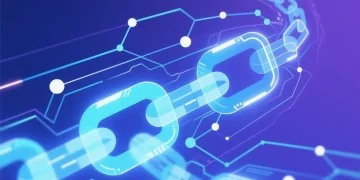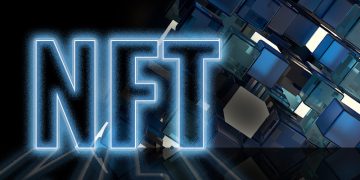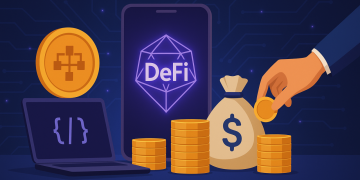Introduction
In recent years, blockchain technology has made significant strides in various industries, with the financial sector being one of the primary areas of interest. The introduction of cryptocurrencies, smart contracts, decentralized finance (DeFi), and other blockchain-based innovations has prompted a rethinking of traditional financial practices. Blockchain, originally developed as the technology behind Bitcoin, is now seen as a revolutionary tool capable of improving transparency, efficiency, and security across many aspects of the financial system.
This article will explore how blockchain technology is transforming traditional financial services, focusing on its impact on payments, lending, trading, regulatory compliance, and more. It will also examine the challenges and opportunities that come with its adoption, and how institutions are embracing this technology to stay competitive in an increasingly digital world.
Section 1: Blockchain Basics and its Core Principles
Before delving into the specific ways blockchain is transforming the financial sector, it is crucial to understand the fundamental principles behind the technology.
- What is Blockchain?
- A blockchain is a decentralized, distributed ledger that records transactions across multiple computers. Each “block” contains a list of transactions and is cryptographically linked to the previous block, creating an immutable chain.
- Unlike centralized systems, blockchain does not rely on a single trusted intermediary, such as a bank or government entity, for validation. Instead, consensus mechanisms (e.g., proof of work, proof of stake) are used to validate transactions.
- Key Features of Blockchain:
- Decentralization: No central authority controls the network, which reduces the risk of single points of failure.
- Transparency: Transactions are visible to all participants in the network, providing a level of transparency.
- Security: Blockchain uses cryptography to secure transactions, ensuring that once a block is added to the chain, it cannot be altered.
- Immutability: Once data is recorded on the blockchain, it cannot be changed or deleted, providing a permanent record of transactions.
- Blockchain Consensus Mechanisms:
- Proof of Work (PoW): Used by Bitcoin and Ethereum, PoW requires participants (miners) to solve complex mathematical puzzles to validate transactions and add new blocks to the blockchain.
- Proof of Stake (PoS): Validators are chosen based on the amount of cryptocurrency they hold and are willing to “stake” as collateral, reducing energy consumption compared to PoW.
- Delegated Proof of Stake (DPoS): A variation of PoS where token holders vote for a few delegates to validate transactions.
Section 2: Blockchain’s Role in Payments and Cross-Border Transactions
One of the most significant areas where blockchain is making a difference is in the realm of payments and cross-border transactions. Traditional banking systems often rely on intermediaries, such as clearinghouses, to process payments, especially for international transfers. These systems can be slow, costly, and prone to errors. Blockchain, on the other hand, offers the potential for faster, cheaper, and more secure transactions.
- Faster Payments
- Traditional cross-border payments can take days to settle due to intermediaries and time zone differences. Blockchain transactions, however, can be settled in minutes or even seconds, regardless of geographic location.
- The use of decentralized networks eliminates the need for intermediaries, reducing transaction time.
- Cost Reduction
- International money transfers are often expensive due to fees charged by banks, remittance services, and other intermediaries. Blockchain can significantly lower these fees, making it more accessible for people to send money across borders.
- Cryptocurrencies like Bitcoin, Ripple (XRP), and Stellar (XLM) offer low transaction costs compared to traditional financial networks such as SWIFT.
- Cross-Border Transactions
- Blockchain enables the seamless transfer of funds across borders without the need for intermediary banks or currency exchanges. This opens up new possibilities for remittance services and businesses operating internationally.
- For example, Ripple’s network uses XRP to facilitate cross-border payments in a cost-effective and efficient manner, allowing financial institutions to settle transactions in real-time.
- Banking the Unbanked
- Blockchain can help provide financial services to people in underbanked or unbanked regions. By using a blockchain-based wallet, individuals can participate in the global financial system without needing access to traditional banking infrastructure.
Section 3: Decentralized Finance (DeFi) and its Disruptive Impact
One of the most transformative applications of blockchain in the financial industry is the rise of decentralized finance (DeFi). DeFi refers to the use of blockchain-based platforms and cryptocurrencies to recreate and improve upon traditional financial services without relying on centralized intermediaries such as banks.
- What is DeFi?
- DeFi applications leverage blockchain and smart contracts to enable financial activities like lending, borrowing, trading, and insurance, all without the need for traditional financial institutions.
- Popular DeFi platforms include Ethereum-based protocols such as Uniswap (for decentralized exchanges), Aave (for lending), and MakerDAO (for stablecoins).
- Key Features of DeFi:
- Decentralization: No central authority controls DeFi platforms, and users have full ownership of their assets.
- Smart Contracts: DeFi relies on smart contracts to execute transactions automatically, ensuring that all parties adhere to agreed terms without intermediaries.
- Liquidity Pools: Users can provide liquidity to DeFi platforms in exchange for rewards, such as interest or trading fees.
- Tokenization of Assets: DeFi allows the creation of tokenized versions of real-world assets, such as real estate or stocks, which can be traded and used as collateral in decentralized lending markets.
- Impact on Traditional Banking and Lending
- In traditional finance, borrowing and lending involve lengthy processes, high fees, and reliance on intermediaries such as banks. DeFi platforms, however, allow for peer-to-peer lending and borrowing, offering greater access and lower costs.
- DeFi protocols offer users the opportunity to earn interest on their cryptocurrency holdings through decentralized lending platforms, a service traditionally provided by banks.
- Challenges and Risks
- While DeFi offers significant advantages, it also introduces new risks. The lack of regulatory oversight, the possibility of smart contract vulnerabilities, and the risk of hacks or scams are major concerns.
- Despite these risks, the growing popularity of DeFi platforms indicates a shift toward decentralized finance as a viable alternative to traditional banking.

Section 4: Blockchain’s Impact on Trading and Asset Management
The financial industry has long relied on traditional stock exchanges and asset managers to facilitate trading and investments. However, blockchain technology has introduced new ways of managing assets, trading securities, and reducing inefficiencies in financial markets.
- Tokenized Assets
- Blockchain enables the creation of tokenized versions of assets like stocks, bonds, real estate, and even art. These tokenized assets can be traded on blockchain-based platforms, opening up new markets and increasing liquidity.
- Tokenization allows for fractional ownership, making it easier for smaller investors to participate in high-value assets like real estate or fine art.
- Blockchain in Stock Exchanges
- Traditional stock exchanges are often slow and expensive due to the multiple intermediaries involved in trading. Blockchain can help streamline these processes by enabling real-time settlement and reducing the need for clearinghouses.
- Projects like Nasdaq’s Linq platform have explored using blockchain to issue, transfer, and settle shares of private companies.
- Decentralized Exchanges (DEXs)
- Unlike centralized exchanges (CEXs) such as Coinbase or Binance, decentralized exchanges (DEXs) allow users to trade cryptocurrencies directly with each other, without an intermediary. This reduces the risks associated with centralized exchanges, such as hacking or mismanagement of funds.
- DEXs also provide increased privacy and control over user funds, as they do not require users to deposit their assets into an exchange wallet.
- Smart Contracts for Asset Management
- Asset managers are increasingly exploring the use of smart contracts to automate the process of managing portfolios and executing trades. This reduces the potential for human error and ensures that transactions are executed according to pre-set rules.
Section 5: Blockchain’s Role in Regulatory Compliance and KYC
Regulatory compliance and Know Your Customer (KYC) processes are central to the operation of the financial industry. However, these processes are often cumbersome, expensive, and prone to inefficiencies. Blockchain can play a significant role in improving compliance and KYC procedures.
- Improved KYC/AML Compliance
- Blockchain technology can streamline the KYC process by creating a decentralized and immutable record of customer identities. Once verified, this information can be shared across financial institutions, reducing the need for repeated verifications.
- Blockchain can also enhance Anti-Money Laundering (AML) procedures by providing transparent and traceable transaction histories that are difficult to alter.
- Smart Contracts for Regulatory Compliance
- Smart contracts can automate compliance processes, ensuring that financial transactions meet regulatory requirements. For example, smart contracts can automatically enforce rules regarding taxes, reporting, and cross-border payments.
- Auditing and Transparency
- Blockchain’s immutable nature provides a reliable and transparent record of all transactions. This can significantly simplify the auditing process, allowing regulators to verify transactions and financial activities in real-time.
Conclusion
Blockchain technology is rapidly transforming the financial sector, offering improvements in areas such as payments, lending, trading, and compliance. The rise of decentralized finance (DeFi), the tokenization of assets, and the potential for blockchain to disrupt traditional banking models are just the beginning. However, the adoption of blockchain is not without its challenges, including scalability, regulatory hurdles, and security concerns.
As blockchain continues to evolve, financial institutions must embrace these changes and explore ways to integrate blockchain into their existing operations. The future of finance is increasingly decentralized, transparent, and efficient—thanks to the transformative power of blockchain technology.
















































